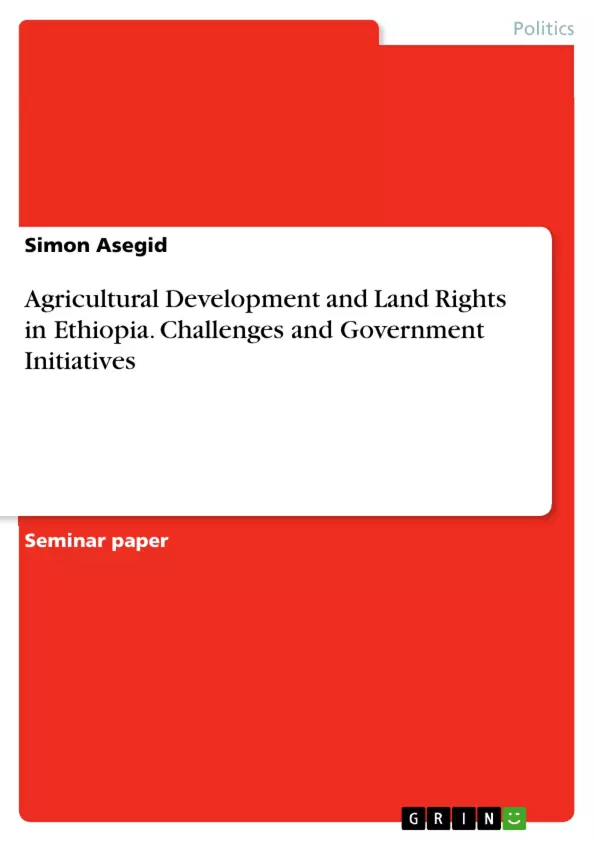Ethiopia's economy is heavily reliant on agriculture, with approximately 85% of the total employment located in the agricultural sector. Rural land is a crucial source of income and plays a significant role in providing food for the population. However, Ethiopia has faced persistent food insecurity, especially in rural areas, due to factors such as small landholdings, land degradation, and the impact of climate change and drought.
This paper examines the significance of rural land use in Ethiopia, the importance of understanding land use patterns and trends, and the key drivers of rural land use changes. It provides a background on Ethiopia's rural landscape, the historical context of land tenure and management systems, and the patterns and trends in rural land use. The paper highlights the key drivers of rural land use changes, including population growth and urbanization, agricultural modernization and commercialization, infrastructure development, environmental factors, and government policies and programs. It also discusses the impacts of these land use changes, such as effects on food security and rural livelihoods, implications for natural resource management and biodiversity, and social and economic disparities between different rural communities. The paper concludes by discussing policy responses and interventions, including land tenure reforms, agricultural development strategies, and environmental protection and natural resource management initiatives. It also identifies challenges and limitations of current policy approaches and provides recommendations for addressing the complex landscape of rural land use in Ethiopia.
Inhaltsverzeichnis (Table of Contents)
- Introduction
- The significance of rural land use in Ethiopia
- The importance of understanding land use patterns and trends in the country's development
- Background on Ethiopia's Rural Landscape
- Geographical overview of Ethiopia's major rural regions and ecosystems
- Ethiopia Use of Natural Resources.
- Historical context of land tenure and management systems in rural Ethiopia
- Northern Ethiopia.
- Southern Ethiopia .....
- Key Drivers of Rural Land Use Changes
- Population growth and urbanization
- Agricultural modernization and commercialization.
- Infrastructure development....
- Rural Road Development..
- Irrigation Development...
- Environmental factors
- Government policies and programs.
- Patterns and Trends in Rural Land Use
- Changes in crop cultivation
- Livestock production and grazing land use
- Deforestation and land clearing for agriculture
- Expansion of rural settlements and infrastructure
- Impacts of Land Use Changes
- Effects on food security and rural livelihoods.
- Implications for natural resource management and biodiversity.
- Social and economic disparities between different rural communities.
- Sustainability concerns and environmental degradation.........
- Policy Responses and Interventions
- Land tenure reforms and land administration programs.
- Agricultural development strategies...........
- Environmental protection and natural resource management initiatives
- Challenges and limitations of current policy approaches
Zielsetzung und Themenschwerpunkte (Objectives and Key Themes)
The paper aims to examine the complex dynamics of rural land use in Ethiopia, considering its significance for the country's economy, food security, and rural livelihoods. It explores the historical context, key drivers, patterns and trends, and impacts of land use changes, analyzing the challenges and limitations of current policy approaches.
- The importance of rural land use in Ethiopia's agricultural sector and food security.
- The drivers of land use change, including population growth, urbanization, agricultural modernization, and government policies.
- The impacts of land use changes on rural livelihoods, natural resource management, and the environment.
- The need for sustainable land management practices and policy interventions to address the challenges of land use change in Ethiopia.
- The significance of understanding land use patterns and trends for informing sustainable development, natural resource management, and climate change adaptation.
Zusammenfassung der Kapitel (Chapter Summaries)
The paper begins by introducing the critical role of rural land use in Ethiopia's economy and its implications for food security. It highlights the challenges of small landholdings, land degradation, and the impact of climate change, emphasizing the importance of sustainable land management. The following chapters delve into the background of Ethiopia's rural landscape, exploring its geographical overview, the historical context of land tenure and management systems, and the country's use of natural resources. The paper then analyzes key drivers of rural land use changes, including population growth, agricultural modernization, infrastructure development, environmental factors, and government policies. It examines the patterns and trends in land use, focusing on changes in crop cultivation, livestock production, deforestation, and expansion of rural settlements. The impacts of these changes are discussed in detail, highlighting effects on food security, rural livelihoods, natural resource management, biodiversity, and social and economic disparities between different communities. The final chapter explores policy responses and interventions, including land tenure reforms, agricultural development strategies, and environmental protection initiatives, while acknowledging the challenges and limitations of current approaches.
Schlüsselwörter (Keywords)
The main focus of the paper is on rural land use in Ethiopia. The key terms and concepts discussed include: land tenure, land management, sustainable land management, land use change, agricultural development, food security, rural livelihoods, environmental degradation, climate change, population growth, urbanization, infrastructure development, natural resource management, policy interventions, and development challenges.
- Quote paper
- Simon Asegid (Author), 2024, Agricultural Development and Land Rights in Ethiopia. Challenges and Government Initiatives, Munich, GRIN Verlag, https://www.hausarbeiten.de/document/1493575


